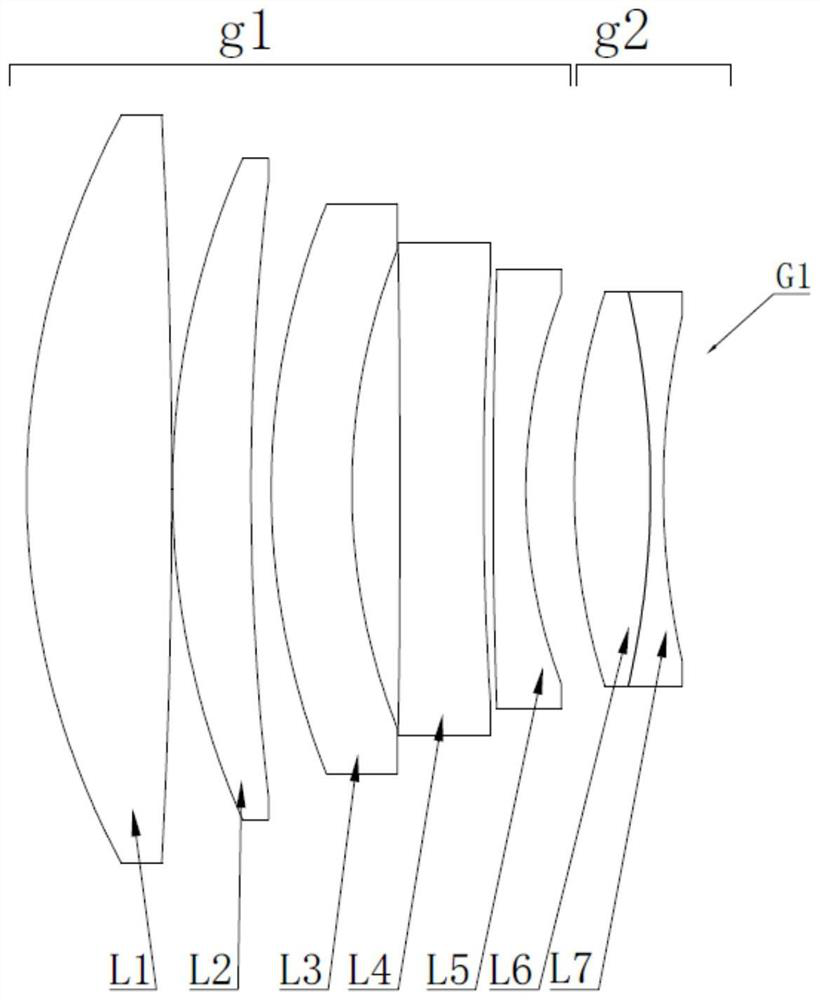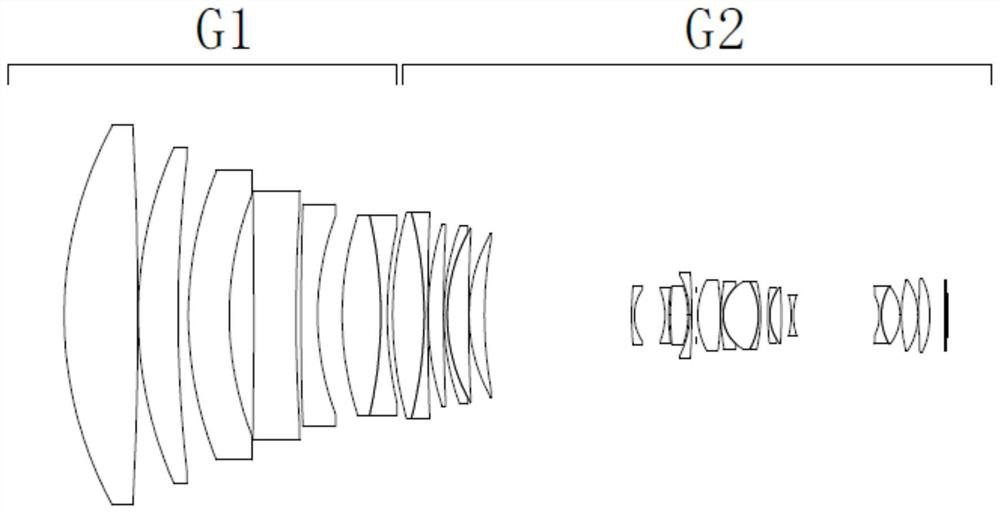Front magnifier and imaging device
A magnifying mirror and lens technology, applied in the optical field, can solve the problems of increasing field of view angle requirements, higher zoom ratio requirements, and reduced video resolution, achieving miniaturization and increasing light throughput. , lens smoothing effect
- Summary
- Abstract
- Description
- Claims
- Application Information
AI Technical Summary
Problems solved by technology
Method used
Image
Examples
Embodiment 1
[0062] like figure 1 , 2 As shown in Fig. 8, a pre-multiplier mirror G1, the front-end multiplier G1 sequentially includes from the object plane side to the image plane side:
[0063] a first lens group g1 with negative refractive power and a second lens group g2 with positive refractive power;
[0064] The lenses in the front multiplier G1 are all composed of spherical lenses;
[0065] The front multiplier G1 only includes one set of cemented lenses.
[0066] In this embodiment, the setting of the spherical lens greatly reduces the cost of the pre-converter G1, and at the same time, by limiting the number of cemented lenses, the use of aspheric surfaces is reduced, and the cost of the multiplier G1 is reduced; While increasing the image quality of the main lens G2 that can be adapted, it will not greatly increase the cost of the extender G1, and at the same time, it will not affect the volume of the extender G1 due to the large imaging effect. The image quality of the mai...
Embodiment 2
[0076] like figure 2 and 8 As shown, on the basis of Embodiment 1, in this embodiment, the first lens group g1 consists of a first lens L1 with positive refractive power, a second lens L2 with positive refractive power, a third lens L3 with negative refractive power, The fourth lens L4 with negative refractive power and the fifth lens L5 with negative refractive power are composed.
[0077] Or the first lens group g1 is composed of a first lens L1 with positive refractive power, a second lens L2 with positive refractive power, a third lens L3 with negative refractive power, and a fifth lens L5 with negative refractive power.
[0078] The second lens L2 and the third lens L3 are both meniscus lenses, and both the second lens L2 and the third lens L3 are curved toward the object surface side.
[0079] In this embodiment, the angle of light entering the second lens group g2 is further adjusted through the second lens L2 and the third lens L3, thereby increasing the imaging qua...
Embodiment 3
[0097] like Figure 2 to Figure 7 As shown, an imaging device, from the object plane side to the image plane side, includes:
[0098] Front extender G1;
[0099] main lens G2;
[0100] and an imaging element configured to receive the image formed by the main lens G2.
[0101] The front magnifier G1 includes sequentially from the object plane side to the image plane side:
[0102] a first lens group g1 with negative refractive power and a second lens group g2 with positive refractive power;
[0103] The first lens group g1 consists of a first lens L1 with positive power, a second lens L2 with positive power, a third lens L3 with negative power, a fourth lens L4 with negative power, and a fourth lens L4 with negative power. It consists of five lenses L5.
[0104] The second lens group g2 includes sequentially from the object plane side to the image plane side:
[0105] The sixth lens L6 of positive refractive power and the seventh lens L7 of negative refractive power are c...
PUM
 Login to View More
Login to View More Abstract
Description
Claims
Application Information
 Login to View More
Login to View More - R&D
- Intellectual Property
- Life Sciences
- Materials
- Tech Scout
- Unparalleled Data Quality
- Higher Quality Content
- 60% Fewer Hallucinations
Browse by: Latest US Patents, China's latest patents, Technical Efficacy Thesaurus, Application Domain, Technology Topic, Popular Technical Reports.
© 2025 PatSnap. All rights reserved.Legal|Privacy policy|Modern Slavery Act Transparency Statement|Sitemap|About US| Contact US: help@patsnap.com



